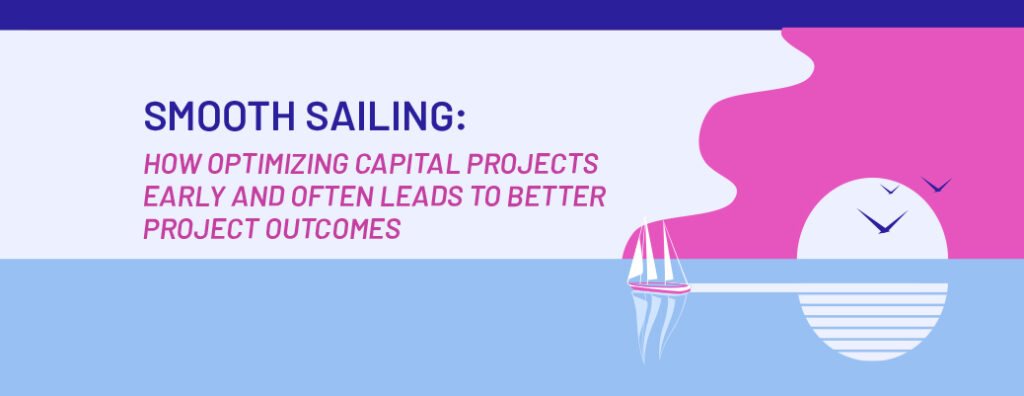
“When You Can’t Predict the Wind, Adjust Your Sails”
Even the most well-intentioned construction projects need to change course along the way, adapting to changing circumstances as they arise. Project controls are essential guideposts for project planning. They allow the project team to identify and mitigate their risks as they establish their time, cost, and quality objectives, and then monitor their progress toward achieving these goals.
Many owners do not implement project control techniques early enough when they provide opportunities to exponentially improve the likelihood of project success. Additionally, many other owners think it is too late to make meaningful changes to scope, budget, or schedule once a project reaches the execution phase. Neither is the case.
Utilizing cost, schedule, and value optimization techniques as the project moves from inception through design, construction, and to occupancy allows ample opportunity to proactively identify issues and adjust course. We call this “continuous optimization,” and it capitalizes on the synergy between cost, schedule, and value management to optimize “early and often.”
Techniques for Optimizing Projects Early
All owners have expectations for their projects – that they meet contract scope, are completed within the contract price/budget, are delivered according to schedule, and meet their return-on-investment forecasts. To have the best chance of meeting these goals, it is best to start early with a few proven optimization techniques:
- Budget development and validation – understanding the owner’s and stakeholders’ goals for the project, funding sources and capabilities, and current market forecasts will provide a good foundation for the development of a robust budget or validation of the same. An early value analysis of project alternatives to determine optimized design concepts is a good technique ahead of design development.
- Project duration analysis – typically performed during the project’s planning phase, this exercise not only develops a project duration based on project “knowns” but also uses risk analysis techniques to model the impact of “unknowns” on the project’s ultimate duration.
- Risk-based contingency analysis – through quantitative risk analysis in the planning phase, appropriate cost and schedule contingencies are derived and allocated to the project at applicable levels. As the design progresses, the risk analysis process is repeated to further refine contingencies.
- Master schedules – integrating schedules for an owner’s other programs and projects with the project to be constructed takes into consideration many stakeholder perspectives and constraints to produce a holistic and realistic assessment of the schedule.
- Value engineering – through an interactive discussion of a project’s required functions, value engineering is used to confirm projects will satisfy all owner requirements and aids in identifying alternatives that will provide project enhancement in cost, constructibility, and long-term performance. In this current climate of escalating costs, value engineering is an optimal tool for pinpointing options to meet a project’s budget limitations.
Techniques for Optimizing Projects Often
Involving project control techniques early in the planning and design phase will have the most significant impact and at the lowest cost to implement any changes. But monitoring along the way has tremendous benefits as well:
- Cost and schedule risk analysis – during design and project execution, utilizing quantitative and qualitative risk analysis and developing estimated cost-to-complete allows the project team to stay informed, identify new or evolving risks, and continue to optimize contingency allocation.
- Continuous estimating – initiated at the earliest of project stages, this model-based estimating tool supports Target Value Design, allowing the project team to produce cost estimates at any point in the development of the design and ensure the design is to budget, with no need to wait for specific design milestones to produce static estimates. Continuous estimating offers estimates in real-time as the design evolves. The project scope, budget, and contingencies are continuously monitored and adjusted based on internal and external impacts.
- Enhanced schedule review – tracking and monitoring project progress can be best optimized through a combination of schedule analysis, earned value analysis, and schedule risk analysis, all scaled to the project’s size and other attributes. Through these techniques, owners can examine not only progress made to date and areas of slippage and gain but also the likelihood of completing within mandated completion dates.
- Integrated schedule review – once construction is underway, incorporating the contractor’s data in the master schedule allows it to continue to serve as an ongoing coordination tool.
These “early and often” efforts to optimize schedule and cost performance also have collateral benefits. They help promote better project synergy by keeping owner and stakeholders continuously informed on cost and schedule, preserving owner design criteria and performance requirements, and providing early opportunities for identifying/mitigating risks. All while generating lessons learned for improvements on future projects.
Smooth sailing on any project involves planning, tracking, and adjusting as you go. By employing enhanced cost, schedule, and value management techniques, a project is better set up for success.
At MBP, we offer project risk management services to help clients plan, identify, analyze, respond to, and monitor and control risks in order to meet project goals. If you are in need of assistance with a project, please contact us for more information.





